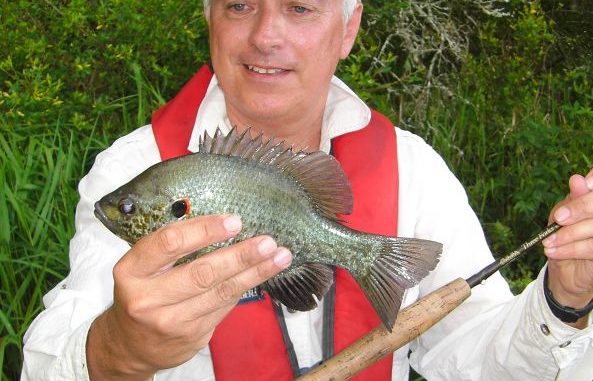
Who says flies can’t catch chinquapin?
“When it comes to redears, leave the fly tackle at home.”
I can’t think of any words that have troubled me more. They would keep me awake at night, that is if I ever slept (sleep is for wimps).
This quote comes from an article I read a year ago. It perpetuates a common misconception about fly fishing.
Lepomis microlophus — better known in Louisiana as chinquapin or shellcrackers — are mostly submergent feeders, preferring snails, small clams, small crawfish, grass shrimp and minnows. Unlike their bluegill cousins, they seldom rise to surface insects.
In addition, unlike bluegill, they spawn in much deeper water. Whereas the typical bluegill bed is no deeper than 3 feet, redear beds can be up to 8 feet deep.
So the misconception that fly fishing is a surface or near-surface sport continues to exist even in the 21st century. Has not everyone heard of heavily-weighted flies or sinking fly lines?
Some 30 years ago, I was ignorant of these, as well. It was a time of fly fishing discovery for me. Living in the Baton Rouge area, I would often fish popping bugs and foam spiders around Lake Verret, the Atchafalaya Spillway, and the Maurepas Swamp.
But False River intrigued me most. Being a dormant oxbow lake, it had clear water year round. And clear water favors the fly rod.
Also, biologists told me it had the highest redear population of any lake in Louisiana. But the key to catching them was using grass shrimp or worms on a weighted hook in 4 to 8 feet of water.
Back then, there were no beadhead flies. Or even freshwater flies with lead eyes. I learned of a large, heavily-weighted fly called a Montana. It came in black and chartreuse, two colors that all bream species love.
The Montana was weighted by using wraps of 20-gauge lead wire around the hook shank, which were then covered with wraps of chenille.
Even as “heavy” as the Montana was — probably 1/124 ounce — it still didn’t get deep enough when using a floating fly line.
So I started experimenting with light leaders. I ended up using an 8-foot leader consisting of 4-feet of 12-pound mono for the butt section and 4-feet of 6-pound mono for the tippet.
Soon I was getting down to the fish and catching as many as my fishing partners who were using commie tackle.
When I got into fly tying, one of the first patterns I learned was the Borger Shrimp. It’s super easy to tie. Using a size 12 wet fly hook, wrap the lead wire around the shank, then wrap either antron or hare fur dubbing the length of the shank. Pick out the fibers a bit and you’re done.
The first fly I created was the Ville Platte Special. It was like the Borger Shrimp except it had rubber split tails and a body of SLF dubbing. I hardly tie it anymore since the Jitterbee is almost identical, easier to tie and catches more fish. And it’s a beadhead fly.
Beads on flies revolutionized fly fishing. First used on trout flies, they were soon applied to bluegill and crappie flies. They allowed anglers to get their flies deeper than before. And, just as important, to help keep the fly in a more horizontal position.
Flies tied on small jigheads — from 1/124 ounce up to 1/64 ounce — also became popular in the early ’90s. One of these was the Fluff Butt. Today it’s tied on both jigheads and standard 3X long hooks using a beadhead.
Today my arsenal for catching chinquapin is a collection of flies using beadheads, jigheads or tiny dumbbell eyes. They include the Fluff Butt, Cap Spider, Jitterbee, Tussel Bug, Coma Minnow, Crappie Candy and the BH Hares Ear.
There are two techniques I use with these flies.
The first one is as follows: Cast the fly out, let it sink for about five to 10 seconds, and then strip in very slowly. I’m talking 2 inches per strip. Most of the strikes will come on the first 10 strips.
The second technique is to fish the fly several feet under a strike indicator. Cast it out, let it settle, then strip it in like you would a floating spider or popping bug. That is, strip an inch or 2, pause, then repeat.
Now that I live in the Cenla area, I’m routinely fly fishing deepwater lakes like Cotile, Kincaid and others. One of those “others” is Caney Lake, which has produced nine of the top 10 redears caught on conventional tackle in Louisiana — all over 1.6 pounds.
April is prime time for big Caney shellcrackers. If the flies and techniques that have worked elsewhere work here, my poor 5-weight fly rod will be put under a lot of stress this coming month.
My advice to you? Fly tackle — NEVER leave home without it!


